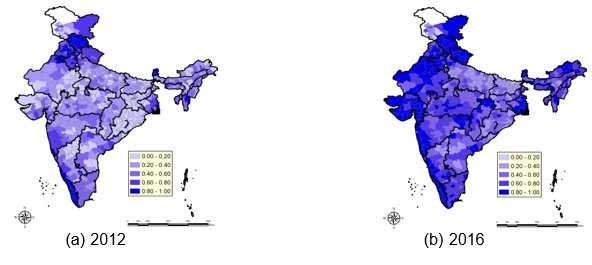Launched on 2 October 2014, Swachh Bharat Mission aimed to increase the proportion of rural households with access to a toilet from 38.8% to 100% by 2019. In the run-up to Gandhi Jayanti and the 5th anniversary of the programme, Mahajan and Sekhri present findings from their research on the effect of the increased in-home toilet access on the risk of violent crimes against women. While access to toilets reduces sexual assault of women, no consistent changes in rape incidence are discerned.
In May 2014, the country was shaken by rapes of two adolescent girls in rural northwestern India, when they were out alone in the evening to defecate in an open field near their house. It brought to attention the plight of women in rural India who were subject to sexual abuse when out and about to defecate in the dark, due to lack of in-home toilets. Subsequent to this incidence, toilet construction took a priority in the ensuing policy discourse in India.
Swachh Bharat Mission: Construction of toilets on a war footing
Despite large increases in per capita income in India in the last 15 years, the rate of open defecation remained persistently high. The proportion of people defecating in the open decreased from 66% in 2000 to 40% in 2015 but still stood in stark contrast to the world average of 12% and Sub-Saharan African countries’ average of 23% (World Development Indicators).
The Swachh Bharat Mission (SBM) – launched in 2014 by the Bharatiya Janata Party (BJP) with the primary aim of addressing this issue – has been significantly more successful than its predecessor programmes: Central Rural
Sanitation Program (1986-1999), Total Sanitation Campaign (2000-2011), and Nirmal Bharat Abhiyan (2012-14) that achieved limited success. The proportion of households having a toilet increased from 24% in 1991 to 47% in 2011 (Census 1991, 2011). On the other hand, SBM has led to construction of 97.6 million toilets across India. As of 2019, the official statistics claim that 99.9% of households in rural India have in-home toilets.1
Figure 1 shows the district-level access to toilets and how it changed between the first and the last year of our study (2012-2016). Clearly there is an uptick in access to toilets but the rate of increase has been different across districts. The programme has not yet been evaluated in terms of its effects on various outcomes. In this article, we share findings from our recent study that evaluates the effect of SBM on public safety of women.2
Figure 1. Proportion of rural households having a toilet
Assessing the effect on women’s safety
Prior research on consequences of open defecation or access to sanitation facilities has focused on health and human capital (Duflo et al. 2015, Patil et al.2014, Geruso and Spears 2018, Coffey et al. 2017, Hammer and Spears 2016, Spears and Lamba 2016), and mortality (Alsan and Goldin 2019). However, in-home toilets can result in enhancing safety of girls and women. We conjecture that in-home toilets reduce exposure time of women outside their homes at dark hours in secluded areas. This results in a reduction in crimes targeted towards women.
We collate a district-level panel data3 by merging reported crimes (National Crime Record Bureau) and construction of toilets during 2012-2016 (Ministry of Drinking Water and Sanitation (MDWS)) since 2016 is the latest year for which crime data is available. A cross-sectional association between toilet construction and crimes against women can result in spurious relationships. There can be other unobservables that reduce crimes, which also influence toilet construction in a district. Hence, we use two ways to ascertain how access to in-home toilets affects women’s safety:
1) First, we use a reduced-form approach. In this methodology, we use within-district variation in toilet construction over the years as they switch from lower number of toilets to a higher number, in response to the SBM. Our design accounts for time invariant features of districts which may have led to construction of more toilets and reduced crime, thus confounding our results. We also account for any macro changes that occur in a specific year in all the sample districts that may influence both the construction of toilets and crimes4.
2) Second, we account for the non-random placement of toilets by using the fact that the largest push for toilets occurred in areas where a greater proportion of state legislative members belonged to the party forming the national government, that is, the BJPin 2014. We rely on this alignment only in close elections, since a BJP candidate winning a close election is plausibly exogenous. Thus, the proportion of legislative assembly election winners by close margins aligned with BJP generates variation in toilet construction that gives us unbiased results. Also, to account for the possible effect of political alignment on overall economic growth of a district (Asher and Novosad 2017), we control for nightlights along with trends in crimes due to initial demographics and development outcomes.
What we find
The estimates from the first methodology we employ, show a reduction in sexual assaults and rapes in areas where more toilets were constructed. They show that a change in the percentage of households with toilets from 0 to a 100% would reduce sexual assaults by a significant 22%. We also find a 14% decline in rapes but this is measured imprecisely.
The empirical analysis shows a significantly positive effect of MLA alignment to BJP, on the pace of toilet construction, during 2015-16. The second methodology we use confirms the previous results for sexual assaults. The marginal affect is larger now with a 100-percentage point change in toilet access reducing sexual assaults by 70%. During 2014-2016, percentage of households having toilets increased by 22% in India. This implies a 15% reduction in sexual assaults against women due to construction of toilets during this period. We show that controlling for trends in other state characteristics do not affect the results. The results for rape are sensitive to our empirical specifications and do not pass our robustness tests. During this period there is also a significant change in reporting of rapes and laws related to rapes. The SBM was launched in 2014 after these changes. Hence, we are not able to infer any statistically meaningful effects on rapes from our data possibly due to these other changes.
Reporting vs. other mechanisms
Crimes against women suffer from underreporting. Insofar as this reporting tendency is time-invariant and varies by regions, this is accounted for in our empirical methodology. But can our result be driven by changes in reporting? We show that these effects are strongest in districts having greater rural population (where the SBM toilet construction was focused) and in areas which are less developed. Reporting would have to vary on all these margins in order to explain our results. There may be a concern that reporting in these crimes was going up during the years 2012-13 in India, especially in northern states. Our results are robust to exclusion of year 2012-13 for sexual assaults. If implementation of the programme was accompanied by greater awareness and in turn reporting going up, then the negative effects would only be obtained if reduction in incidence trumps increased reporting. Hence, our negative effects in areas where more toilets were constructed are reflective of reduction in incidence. We do not discern consistent negative and significant effects on other crimes like theft, kidnapping, and murder; this weighs against general reduction in crimes as a mechanism driving our results.
Concluding remarks
Our analysis shows that access to in-home toilets can have significant effects on public safety of women. Aside from staggering social and financial costs, concerns over safety can also lead to under-investment in human capital by women and reduce their welfare (Borker 2017) and (Chakraborty et al. 2018). We show that improving sanitation facilities in developing countries can be one channel for increasing public safety of women. Our findings are of significant policy relevance. As a policy tool, SBM was successful at increasing access to in-home toilets in rural and remote areas, which in turn led to a reduction in sexual assaults on women. Policies that push for in-home sanitation facilities over open defecation not only effect human capital and health – but also safety and well-being of females.
Notes:
- While the reduction in open defecation may not be one-to-one, there is still a high correlation between access to toilets and open defecation. National Rural Sanitation Survey (NARSS) found that 96.5% of individuals in households having a toilet use their latrines
- Srinivasan (2015) notes a correlation between violence against women and lack of access to in-home toilets using a large-scale cross-sectional survey in India.
- Panel data (also known as longitudinal data) is a dataset in which data for same multiple entities is observed across time.
- These results are robust to several different empirical specifications.
Further Reading
- Alsan, Marcella and Claudia Goldin (2019), “Watersheds in Child Mortality: The Role of Effective Water and Sewerage Infrastructure, 1880–1920”, Journal of Political Economy, 127(2):586-638.
- Asher, Sam and Paul Novosad, 2017. Politics and local economic growth: Evidence from India. American Economic Journal: Applied Economics, 9(1):229-273.
- Borker, G (2017), ‘Safety first: Perceived risk of street harassment and educational choices of women’, Job Market Paper, Department of Economics, Brown University.
- Chakraborty, Tanika, Anirban Mukherjee, Swapnika Reddy Rachapalli and Sarani Saha (2018), “Stigma of sexual violence and women’s decision to work”, World Development, 103:226-238.
- Coffey, Diane, Michael Geruso and Dean Spears (2017), “Sanitation, disease externalities and anaemia: evidence from Nepal”, The Economic Journal, 128(611):1395-1432.
- Duflo, E, M Greenstone, R Guiteras & T Clasen (2015), ‘Toilets Can Work: Short and Medium Run Health Impacts of Addressing Complementarities and Externalities in Water and Sanitation’, National Bureau of Economic Research (NBER) Working Paper.
- Gertler, P, M Shah, ML Alzua, L Cameron, S Martinez and S Patil (2015), ‘How Does Health Promotion Work? Evidence From The Dirty Business of Eliminating Open Defecation’, NBER Working Paper.
- Geruso, Michael and Dean Spears (2018), “Neighborhood sanitation and infant mortality”, American Economic Journal: Applied Economics, 10(2):125-162.
- Hammer, Jeffrey and Dean Spears (2016), “Village sanitation and child health: effects and external validity in a randomized field experiment in rural India”, Journal of Health Economics, 48:135-148.
- Patil, Sumeet R, Benjamin F Arnold, Alicia L Salvatore, Bertha Briceno, Sandipan Ganguly, John M Colford Jr and Paul J Gertler (2014), “The effect of India’s total sanitation campaign on defecation behaviors and child health in rural Madhya Pradesh: A cluster randomized controlled trial”, PLoS medicine, 11(8):e1001709.
- Spears, Dean and Sneha Lamba (2016), “Effects of Early-Life Exposure to Sanitation on Childhood Cognitive Skills: Evidence from India’s Total Sanitation Campaign”, Journal of Human Resources, 51(2):298-327.
- Srinivasan, R (2015), ‘Lack of toilets and violence against Indian women: Empirical evidence and policy implications’. Available here.




 01 October, 2019
01 October, 2019 






Comments will be held for moderation. Your contact information will not be made public.